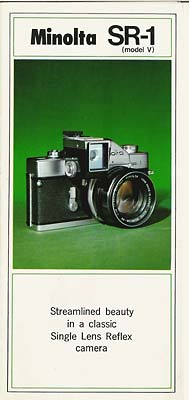The
SR-2 was a great camera and very popular, however it was very expensive.
In order to achieve greater sales, Minolta produced a camera with slightly
lower specifications in July 1959. The SR-1 had a slower top speed of
1/500 sec, and a slower lens, but in all other respects was identical
to the SR-2.
The
Minolta SR-1 was to undergo many variations over its 8 year life, as
it was altered to stay competitive with current trends in photography.
Over this period it remained as the second model in the Minolta line,
and its longevity has contributed to the fact that it is the most readily
available model from the SR Series available today. The different models
of SR-1 released over its life are summarised below.
SR-1
(Model a) - Basic model derived from the SR-2, but with a lower
top speed.
SR-1
(Model b) - Introduced in 1960, the model b had an alteration
to the shutter speed dial so that it no longer needed to be lifted in
order to change the shutter speed. Additionally, a bayonet mount to
the viewfinder was added to facilitate easier use of viewfinder accessories,
and a new anglefinder which incorporated the bayonet mount was released.
SR-1
(Model c) - In August 1961 Minolta intoduced a significant
improvement to its models, being the new fully automatic diaphragm.
With this change, rather than the lens staying stopped down after exposure
until the film was advanced, the camera automatically opened the lens
to full aperture again.
SR-1
(Model d) - In 1962 the SR-1 underwent another significant
change, with the introduction of a new external meter for the camera.
The camera had a mount for this meter attached to the right side of
the body, requiring the SR-1 logo to be moved to the left side. The
new selenium meter was linked to the shutter speed dial, meaning that
as the film speed was adjusted, the meter automatically showed the required
aperture. This system was first introduced with the SR-3 in 1960. After
the introduction of the SR-7 in July 1962 buyers had the choice of the
original Selenium meter, as well as a new, more expensive CdS 'SR meter-2'
with improved low-light sensitivity.
SR-1
(Model e) - In 1963 the camera had a modest update with its
film counter being moved to the right side of the body to match that
of the SR-7.
SR-1
(Model V) - In 1965 Minolta changed the body styling of its
cameras to a squarer style, more in keeping with changing design aesthetics.
In addition, the camera had a new rectangular viewfinder, and a new
Anglefinder V and Viewfinder Magnifier V were introduced. The Anglefinder
V incorporated a prism, with the result that a brighter, unreversed
image was achieved, a significant improvement. The Minolta logo was
moved from the flat front of the prism to the angled portion, and the
meter connection was streamlined, becoming similar to a flash shoe,
as opposed to the previous large rectangular block. A new meter with
a different mount was available for the Model V, being the SR Meter-V.
Finally, a mirror lock up was added, enabling users to utilise the 21mm
super wide angle introduced by the company in 1962.
















